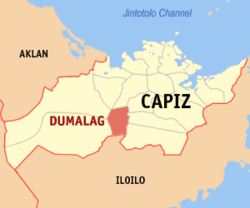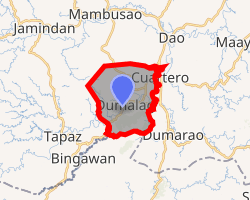Dumalag, Capiz
Dumalag, officially the Municipality of Dumalag (Capiznon/Hiligaynon: Banwa sang Dumalag; Tagalog: Bayan ng Dumalag), is a 4th class municipality in the province of Capiz, Philippines. According to the 2015 census, it has a population of 29,466 people.[3]
Dumalag | |
|---|---|
| Municipality of Dumalag | |
 Map of Capiz with Dumalag highlighted | |
OpenStreetMap 
| |
.svg.png) Dumalag Location within the Philippines | |
| Coordinates: 11°18′N 122°37′E | |
| Country | |
| Region | Western Visayas (Region VI) |
| Province | Capiz |
| District | 2nd district of Capiz |
| Barangays | 19 (see Barangays) |
| Government | |
| • Type | Sangguniang Bayan |
| • Mayor | Amado Eriberto V. Castro Jr. |
| • Vice Mayor | Clemente C. Firmalino Jr. |
| • Congressman | Fredenil H. Castro |
| • Electorate | 21,748 voters (2019) |
| Area | |
| • Total | 109.18 km2 (42.15 sq mi) |
| Population (2015 census)[3] | |
| • Total | 29,466 |
| • Density | 270/km2 (700/sq mi) |
| Economy | |
| • Income class | 4th municipal income class |
| • Poverty incidence | 15.91% (2015)[4] |
| • Revenue (₱) | 82,072,332.11 (2016) |
| Time zone | UTC+8 (PST) |
| ZIP code | 5813 |
| PSGC | |
| IDD : area code | +63 (0)36 |
| Climate type | tropical climate |
| Native languages | Kinaray-a language Capiznon Hiligaynon Tagalog |
| Website | www |
Dumalag is 44 kilometres (27 mi) from Roxas City.
Barangays
Dumalag is politically subdivided into 19 barangays. [2]
- Concepcion
- Consolacion
- Dolores
- Duran
- San Agustin
- San Jose
- San Martin
- San Miguel
- San Rafael
- San Roque
- Santa Carmen
- Santa Cruz
- Santa Monica
- Santa Rita
- Santa Teresa
- Santo Angel
- Santo Niño
- Santo Rosario
- Poblacion
Climate
| Climate data for Dumalag, Capiz | |||||||||||||
|---|---|---|---|---|---|---|---|---|---|---|---|---|---|
| Month | Jan | Feb | Mar | Apr | May | Jun | Jul | Aug | Sep | Oct | Nov | Dec | Year |
| Average high °C (°F) | 27 (81) |
28 (82) |
29 (84) |
31 (88) |
32 (90) |
31 (88) |
30 (86) |
30 (86) |
29 (84) |
29 (84) |
29 (84) |
27 (81) |
29 (85) |
| Average low °C (°F) | 23 (73) |
23 (73) |
23 (73) |
24 (75) |
25 (77) |
25 (77) |
24 (75) |
24 (75) |
24 (75) |
24 (75) |
24 (75) |
23 (73) |
24 (75) |
| Average precipitation mm (inches) | 61 (2.4) |
39 (1.5) |
46 (1.8) |
48 (1.9) |
90 (3.5) |
144 (5.7) |
152 (6.0) |
145 (5.7) |
163 (6.4) |
160 (6.3) |
120 (4.7) |
90 (3.5) |
1,258 (49.4) |
| Average rainy days | 12.3 | 9.0 | 9.9 | 10.0 | 18.5 | 25.0 | 27.4 | 26.0 | 25.9 | 24.9 | 17.9 | 14.2 | 221 |
| Source: Meteoblue [5] | |||||||||||||
Demographics
| Year | Pop. | ±% p.a. |
|---|---|---|
| 1903 | 5,779 | — |
| 1918 | 9,050 | +3.04% |
| 1948 | 13,103 | +1.24% |
| 1960 | 14,934 | +1.10% |
| 1970 | 18,348 | +2.08% |
| 1975 | 20,038 | +1.78% |
| 1980 | 22,198 | +2.07% |
| 1990 | 25,484 | +1.39% |
| 1995 | 28,348 | +2.02% |
| 2000 | 25,920 | −1.90% |
| 2007 | 29,221 | +1.67% |
| 2010 | 29,298 | +0.10% |
| 2015 | 29,466 | +0.11% |
| Source: Philippine Statistics Authority[3][6][7][8] | ||
In the 2015 census, the population of Dumalag was 29,466 people,[3] with a density of 270 inhabitants per square kilometre or 700 inhabitants per square mile.
gollark: Yep: https://discordapp.com/channels/463237927984693259/543382344782970881/622280620004999168
gollark: I'm sure they mentioned somewhere that there was 8MB of flash on it.
gollark: I guess with a watch you can see who's calling?
gollark: Accepting calls would be useful-ish if you have a Bluetooth headset or something on I guess.
gollark: Pebbles, I mean.
References
- "Municipality". Quezon City, Philippines: Department of the Interior and Local Government. Retrieved 31 May 2013.
- "Province: Capiz". PSGC Interactive. Quezon City, Philippines: Philippine Statistics Authority. Retrieved 12 November 2016.
- Census of Population (2015). "Region VI (Western Visayas)". Total Population by Province, City, Municipality and Barangay. PSA. Retrieved 20 June 2016.
- "PSA releases the 2015 Municipal and City Level Poverty Estimates". Quezon City, Philippines. Retrieved 12 October 2019.
- "Dumalag: Average Temperatures and Rainfall". Meteoblue. Retrieved 2 May 2020.
- Census of Population and Housing (2010). "Region VI (Western Visayas)". Total Population by Province, City, Municipality and Barangay. NSO. Retrieved 29 June 2016.
- Censuses of Population (1903–2007). "Region VI (Western Visayas)". Table 1. Population Enumerated in Various Censuses by Province/Highly Urbanized City: 1903 to 2007. NSO.
- "Province of Capiz". Municipality Population Data. Local Water Utilities Administration Research Division. Retrieved 17 December 2016.
External links
This article is issued from Wikipedia. The text is licensed under Creative Commons - Attribution - Sharealike. Additional terms may apply for the media files.